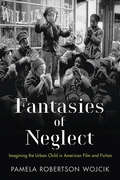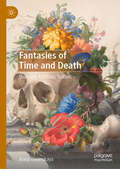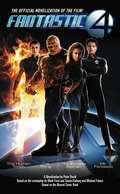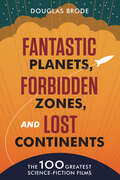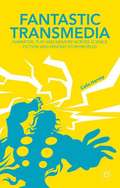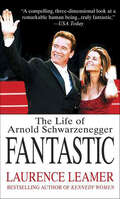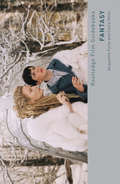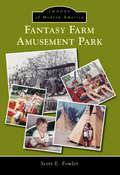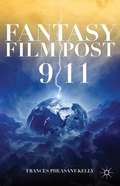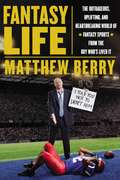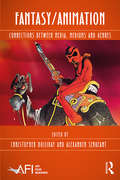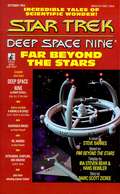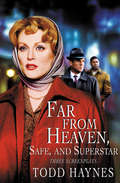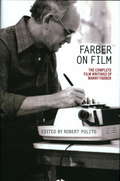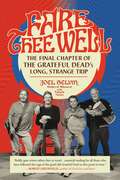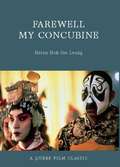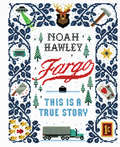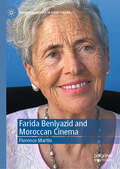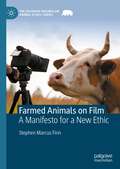- Table View
- List View
Fantasies of Neglect
by Pamela Robertson WojcikIn our current era of helicopter parenting and stranger danger, an unaccompanied child wandering through the city might commonly be viewed as a victim of abuse and neglect. However, from the early twentieth century to the present day, countless books and films have portrayed the solitary exploration of urban spaces as a source of empowerment and delight for children. Fantasies of Neglect explains how this trope of the self-sufficient, mobile urban child originated and considers why it persists, even as it goes against the grain of social reality. Drawing from a wide range of films, children's books, adult novels, and sociological texts, Pamela Robertson Wojcik investigates how cities have simultaneously been demonized as dangerous spaces unfit for children and romanticized as wondrous playgrounds that foster a kid's independence and imagination. Charting the development of free-range urban child characters from Little Orphan Annie to Harriet the Spy to Hugo Cabret, and from Shirley Temple to the Dead End Kids, she considers the ongoing dialogue between these fictional representations and shifting discourses on the freedom and neglect of children. While tracking the general concerns Americans have expressed regarding the abstract figure of the child, the book also examines the varied attitudes toward specific types of urban children--girls and boys, blacks and whites, rich kids and poor ones, loners and neighborhood gangs. Through this diverse selection of sources, Fantasies of Neglect presents a nuanced chronicle of how notions of American urbanism and American childhood have grown up together.
Fantasies of Neglect: Imagining the Urban Child in American Film and Fiction
by Pamela Robertson WojcikIn our current era of helicopter parenting and stranger danger, an unaccompanied child wandering through the city might commonly be viewed as a victim of abuse and neglect. However, from the early twentieth century to the present day, countless books and films have portrayed the solitary exploration of urban spaces as a source of empowerment and delight for children. Fantasies of Neglect explains how this trope of the self-sufficient, mobile urban child originated and considers why it persists, even as it goes against the grain of social reality. Drawing from a wide range of films, children's books, adult novels, and sociological texts, Pamela Robertson Wojcik investigates how cities have simultaneously been demonized as dangerous spaces unfit for children and romanticized as wondrous playgrounds that foster a kid's independence and imagination. Charting the development of free-range urban child characters from Little Orphan Annie to Harriet the Spy to Hugo Cabret, and from Shirley Temple to the Dead End Kids, she considers the ongoing dialogue between these fictional representations and shifting discourses on the freedom and neglect of children. While tracking the general concerns Americans have expressed regarding the abstract figure of the child, the book also examines the varied attitudes toward specific types of urban children--girls and boys, blacks and whites, rich kids and poor ones, loners and neighborhood gangs. Through this diverse selection of sources, Fantasies of Neglect presents a nuanced chronicle of how notions of American urbanism and American childhood have grown up together.
Fantasies of Time and Death: Dunsany, Eddison, Tolkien
by Anna VaninskayaThis book reveals the unique contribution made by the three founding fathers of British fantasy—Lord Dunsany, E. R. Eddison and J. R. R. Tolkien—to our culture’s perennial reassessment of the meanings of time, death and eternity. It traces the poetic, philosophical and theological roots of the striking preoccupation with mortality and temporality that defines the imagined worlds of early fantasy fiction, and gives both the form of such fiction and its ideas the attention they deserve. Dunsany, Eddison and Tolkien raise some of the oldest questions in existence: about the limits of nature, human and divine; cosmic creation and destruction; the immortality conferred by art and memory; and the paradoxes and uncertainties generated by the universal experience of transience, the fear of annihilation and the desire for transcendence. But they respond to those questions by means of thought experiments that have no precedent in modern literary history.
Fantasies of the Master Race: Literature, Cinema and the Colonization of American Indians
by Ward Churchill M. Annette JaimesIn this volume of incisive essays, Ward Churchill looks at representations of American Indians in literature and film, delineating a history of cultural propaganda that has served to support the continued colonization of Native America. During each phase of the genocide of American Indians, the media has played a critical role in creating easily digestible stereotypes of Indians for popular consumption. Literature about Indians was first written and published in order to provoke and sanctify warfare against them. Later, the focus changed to enlisting public support for "civilizing the savages," stripping them of their culture and assimilating them into the dominant society. Now, in the final stages of cultural genocide, it is the appropriation and stereotyping of Native culture that establishes control over knowledge and truth.
Fantastic Beasts: The Crimes of Grindelwald - The Original Screenplay (Harry Potter)
by J. K. Rowling Mina Lima<p>J.K. Rowling's five-film Fantastic Beasts adventure series continues with the original screenplay for Fantastic Beasts: The Crimes of Grindelwald. <p>At the end of Fantastic Beasts and Where to Find Them, the powerful Dark wizard Gellert Grindelwald was captured in New York with the help of Newt Scamander. But, making good on his threat, Grindelwald escapes custody and sets about gathering followers, most unsuspecting of his true agenda: to raise pure-blood wizards up to rule over all non-magical beings. <p>In an effort to thwart Grindelwald's plans, Albus Dumbledore enlists Newt, his former Hogwarts student, who agrees to help once again, unaware of the dangers that lie ahead. Lines are drawn as love and loyalty are tested, even among the truest friends and family, in an increasingly divided wizarding world. <p>This second original screenplay from J.K. Rowling, illustrated with stunning line art from MinaLima, expands on earlier events that helped shape the wizarding world, with some surprising nods to the Harry Potter stories that will delight fans of both the books and films.</p>
Fantastic Four: Official novelization of the new film
by Peter DavidScientific genius Dr. Reed Richards' lifelong dream is close to being realized--a trip to space and to the center of a cosmic storm to unlock the secrets of the human genetic code. Financed by rival-turned-billionaire-industrialist Victor Von Doom, Reed's crew for the mission includes his best friend, astronaut Ben Grimm; Susan Storm, Von Doom's director of genetic research and Reed's ex-girlfriend; and Sue's hot-headed younger brother, pilot Johnny Storm. With benefactor Von Doom in tow, the four set off for the exploration of a lifetime. But something goes terribly wrong, as cosmic radiation irrevocably alters their DNA and their future. Back on Earth, the effects of the exposure are quickly revealed: Reed gains the ability to stretch and contort his body into any shape he can imagine. Sue is able to render herself invisible and to create and project powerful force fields. Johnny can now engulf his body in flames and take flight at will, and Ben, whose freakish transmutation is the most shocking, becomes an orange-colored, rock-like, superhumanly strong creature. Together, they turn tragedy into triumph and catastrophe into coalition, and must use their unique and formidable powers against Victor Von Doom--who has also not escaped the effects of the cosmic storm unscathed. Adventurers. Super Heroes. Celebrities. To the world, they are the Fantastic Four. To each other, they are a family.
Fantastic Planets, Forbidden Zones, and Lost Continents: The 100 Greatest Science-Fiction Films
by Douglas BrodeWhether you judge by box office receipts, industry awards, or critical accolades, science fiction films are the most popular movies now being produced and distributed around the world. Nor is this phenomenon new. Sci-fi filmmakers and audiences have been exploring fantastic planets, forbidden zones, and lost continents ever since George Méliès’ 1902 film A Trip to the Moon. In this highly entertaining and knowledgeable book, film historian and pop culture expert Douglas Brode picks the one hundred greatest sci-fi films of all time. Brode’s list ranges from today’s blockbusters to forgotten gems, with surprises for even the most informed fans and scholars. He presents the movies in chronological order, which effectively makes this book a concise history of the sci-fi film genre. A striking (and in many cases rare) photograph accompanies each entry, for which Brode provides a numerical rating, key credits and cast members, brief plot summary, background on the film’s creation, elements of the moviemaking process, analysis of the major theme(s), and trivia. He also includes fun outtakes, including his top ten lists of Fifties sci-fi movies, cult sci-fi, least necessary movie remakes, and “so bad they’re great” classics—as well as the ten worst sci-fi movies (“those highly ambitious films that promised much and delivered nil”). So climb aboard spaceship Brode and journey to strange new worlds from Metropolis (1927) to Guardians of the Galaxy (2014).
Fantastic Planets, Forbidden Zones, and Lost Continents: The 100 Greatest Science-Fiction Films
by Douglas BrodeWhether you judge by box office receipts, industry awards, or critical accolades, science fiction films are the most popular movies now being produced and distributed around the world. Nor is this phenomenon new. Sci-fi filmmakers and audiences have been exploring fantastic planets, forbidden zones, and lost continents ever since George Méliès’ 1902 film A Trip to the Moon. In this highly entertaining and knowledgeable book, film historian and pop culture expert Douglas Brode picks the one hundred greatest sci-fi films of all time. Brode’s list ranges from today’s blockbusters to forgotten gems, with surprises for even the most informed fans and scholars. He presents the movies in chronological order, which effectively makes this book a concise history of the sci-fi film genre. A striking (and in many cases rare) photograph accompanies each entry, for which Brode provides a numerical rating, key credits and cast members, brief plot summary, background on the film’s creation, elements of the moviemaking process, analysis of the major theme(s), and trivia. He also includes fun outtakes, including his top ten lists of Fifties sci-fi movies, cult sci-fi, least necessary movie remakes, and “so bad they’re great” classics—as well as the ten worst sci-fi movies (“those highly ambitious films that promised much and delivered nil”). So climb aboard spaceship Brode and journey to strange new worlds from Metropolis (1927) to Guardians of the Galaxy (2014).
Fantastic Transmedia: Narrative, Play and Memory Across Science Fiction and Fantasy Storyworlds
by Colin B. HarveyContemporary culture is packed with fantasy and science fiction storyworlds extending across multiple media platforms. This book explores the myriad ways in which imaginary worlds use media like films, novels, videogames, comic books, toys and increasingly user-generated content to captivate and energise contemporary audiences.
Fantastic Voyages of the Cinematic Imagination: Georges Méliès's Trip to the Moon (SUNY series, Horizons of Cinema)
by Matthew Solomon"Best moving pictures I ever saw." Thus did one Vaudeville theater manager describe Georges Méliès's A Trip to the Moon [Le Voyage dans la lune], after it was screened for enthusiastic audiences in October 1902. Cinema's first true blockbuster, A Trip to the Moon still inspires such superlatives and continues to be widely viewed on DVD, on the Internet, and in countless film courses. In Fantastic Voyages of the Cinematic Imagination, leading film scholars examine Méliès's landmark film in detail, demonstrating its many crucial connecions to literature, popular culture, and visual culture of the time, as well as its long "afterlife" in more recent films, television, and music videos. Together, these essays make clear that Méliès was not only a major filmmaker but also a key figure in the emergence of modern spectacle and the birth of the modern cinematic imagination, and by bringing interdisciplinary methodologies of early cinema studies to bear on A Trip to the Moon, the contributors also open up much larger questions about aesthetics, media, and modernity.In his introduction, Matthew Solomon traces the convoluted provenance of the film's multiple versions and its key place in the historiography of cinema, and an appendix contains a useful dossier of primary-source documents that contextualize the film's production, along with translations of two major articles written by Méliès himself.
Fantastic: The Life of Arnold Schwarzenegger
by Laurence LeamerThe life of Arnold Schwarzenegger is one of the most remarkable success stories in the U.S. Here is a young man from an Austrian village who became the greatest bodybuilder in history, a behemoth who even today in retirement is the dominating figure in the sport. Here is an immigrant with a heavy accent and a four syllable last name, who marries a Kennedy princess and becomes the number one movie star in the world, an icon known and celebrated everywhere. Here is a political novice with no administrative experience who becomes governor of California in one of the most unusual and controversial elections in American history, and confounds his critics by proving an effective, popular leader. In Fantastic, Leamer shows how and why this man of willful ambition and limitless drive achieved his unprecedented accomplishments. As the author of a celebrated trilogy on the Kennedy family, Leamer has access to a unique array of sources. Leamer traveled with candidate Schwarzenegger during the gubernatorial campaign. He has interviewed Governor Schwarzenegger and his wife Maria Shriver, and their closest friends and associates, most of whom had never talked to an author before. The result is a startlingly intimate book, the pages studded with news making revelations. This book of passionate intensity captures a Schwarzenegger unlike any other public figure of our time, a unique political/cultural figure, his time in Sacramento only a way station on a journey where no one has traveled before. The book captures the personal Schwarzenegger, too, and the story of his single days, marriage, and family life. No one who reads this book will ever see Schwarzenegger in the same way again.
Fantasy (Routledge Film Guidebooks)
by Claire Hines Jacqueline FurbyFantasy addresses a previously neglected area within film studies. The book looks at the key aesthetics, themes, debates and issues at work within this popular genre and examines films and franchises that illustrate these concerns. Contemporary case studies include: Alice in Wonderland (2010) Avatar (2009) The Dark Knight (2008) Edward Scissorhands (1990) Lord of the Rings (2001-2003) Pirates of the Caribbean (2003-2007) Prince of Persia: The Sands of Time (2010) Shrek (2001) Twelve Monkeys (1995) The authors also consider fantasy film and its relationship to myth, legend and fairy tale, examining its important role in contemporary culture. The book provides an historical overview of the genre, its influences and evolution, placing fantasy film within the socio-cultural contexts of production and consumption and with reference to relevant theory and critical debates. This is the perfect introduction to the world of fantasy film and investigates the links between fantasy film and gender, fantasy film and race, fantasy film and psychoanalysis, fantasy film and technology, fantasy film storytelling and spectacle, fantasy film and realism, fantasy film and adaptation, and fantasy film and time.
Fantasy Farm Amusement Park
by Scott E. FowlerNot many developers would build an amusement park next door to the successful LeSourdsville Lake amusement park, but Edgar Streifthau was a one-of-a-kind man in Butler County, Ohio. Streifthau, the original owner of LeSourdsville, was forced to sell his beloved park, but he still had the amusement-park bug, and in 1963 he built Fantasy Farm directly next to LeSourdsville. Fantasy Farm's audience was young children, and the concept was successful for decades. The two parks coexisted for 28 years despite periodically appearing in court opposite each other. In 1982, Streifthau sold Fantasy Farm to local carnival owner William Johnson, who ran the park for another decade before finally becoming a victim of the economy. Johnson closed Fantasy Farm in 1991 and sold off all of its assets.
Fantasy Film Post 9/11
by Frances Pheasant-KellyExamining a range of fantasy films released in the past decade, Pheasant-Kelly looks at why these films are meaningful to current audiences. The imagery and themes reflecting 9/11, millennial anxieties, and environmental disasters have furthered fantasy's rise to dominance as they allow viewers to work through traumatic memories of these issues.
Fantasy Life: The Outrageous, Uplifting, and Heartbreaking World of Fantasy Sports from the Guy Who's Lived It
by Matthew BerryAn inside look at the world of fantasy sports from America's most trusted name in the industry. Berry explores the increasingly ubiquitious world of fantasy sports. Every year, millions of people spend their time assembling, managing and obsessing over fantasy teams.
Fantasy/Animation: Connections Between Media, Mediums and Genres (AFI Film Readers)
by Christopher Holliday Alexander SergeantThis book examines the relationship that exists between fantasy cinema and the medium of animation. Animation has played a key role in defining our collective expectations and experiences of fantasy cinema, just as fantasy storytelling has often served as inspiration for our most popular animated film and television. Bringing together contributions from world-renowned film and media scholars, Fantasy/Animation considers the various historical, theoretical, and cultural ramifications of the animated fantasy film. This collection provides a range of chapters on subjects including Disney, Pixar, and Studio Ghibli, filmmakers such as Ralph Bakshi and James Cameron, and on film and television franchises such as Dreamworks’ How To Train Your Dragon (2010–) and HBO’s Game of Thrones (2011–).
Far Beyond The Stars (Star Trek)
by Steven BarnesWithout warning, Benjamin Sisko is living another life. No longer a Starfleet captain, commander of space station Deep Space Nine, he is Benny Russell, a struggling science fiction writer living in 1950s Harlem. Benny has a dream, of a place called Deep Space Nine and a man named Ben Sisko, and a story he has to tell. But is the Earth of that era ready for a black science fiction hero? Everyone tells him no, but Benny cannot abandon his dream. One way or another, he will tell the world about Captain Benjamin Sisko and Deep Space Nine.
Far From Heaven, Safe, and Superstar: Three Screenplays
by Todd HaynesThree acclaimed screenplays from one of today’s most provocative filmmakers, including the Oscar nominated screenplay Far from Heaven. An award-winning auteur and a pioneer of the New Queer Cinema movement, Todd Haynes has achieved both critical acclaim and box office success with his original, intelligent, and often controversial films. Collected here are three of his most celebrated screenplays. Far from Heaven: Winning fifty critics’ prizes and appearing on two hundred Top Ten lists, Far from Heaven was also nominated for four Academy Awards. Inspired by the films of Douglas Sirk, it tells the story of a 1950s housewife who is alienated by her neighbors when she pursues an affair with her African American gardener after learning of her husband’s homosexuality. Safe: Haynes’s breakthrough feature was voted Best Film of the 1990s by the Village Voice Film Critics Poll. It tells the disturbing story of an affluent suburban housewife whose life is shattered by a mysterious illness. One character suggests that perhaps she is “allergic to the twentieth century.” Superstar: The Karen Carpenter Story: Told with a cast of Barbie dolls, this short film about Karen Carpenter’s battle with anorexia was named one of Entertainment Weekly’s Top 50 Cult Movies in 2003. Though the film was ordered destroyed after a lawsuit by the Carpenter estate, it remains an underground classic and “the most talked-about, least-seen film of the ’80s” (The A.V. Club).
Farber on Film: The Complete Film Writings of Manny Faber
by Robert Polito Manny FarberManny Farber (1917-2008) was a unique figure among American movie critics. <P><P>Champion of what he called "termite art" (focused, often eccentric virtuosity as opposed to "white elephant" monumentality), master of a one-of-a-kind prose style whose jazz-like phrasing and incandescent twists and turns made every review an adventure, he has long been revered by his peers. Susan Sontag called him "the liveliest, smartest, most original film critic this country ever produced"; for Peter Bogdanovich, he was "razor-sharp in his perceptions" and "never less than brilliant as a writer."Farber was an early discoverer of many filmmakers later acclaimed as American masters: Val Lewton, Preston Sturges, Samuel Fuller, Raoul Walsh, Anthony Mann. A prodigiously gifted painter himself, he brought to his writing an artist's eye for what was on the screen. Alert to any filmmaker, no matter how marginal or unsung, who was "doing go-for-broke art and not caring what comes of it," he was uncompromising in his contempt for pretension and trendiness, for, as he put it, directors who "pin the viewer to the wall and slug him with wet towels of artiness and significance." The excitement of his criticism, however, has less to do with his particular likes and dislikes than with the quality of attention he paid to each film as it unfolds, to the "chains of rapport and intimate knowledge" in its moment-to-moment reality. To transcribe that knowledge he created a prose that, in Robert Polito's words, allows for "oddities, muddles, crises, contradictions, dead ends, multiple alternatives, and divergent vistas." The result is critical essays that are themselves works of art. Farber on Film brings together this extraordinary body of work in its entirety for the first time, from his early and previously uncollected weekly reviews for The New Republic and The Nation to his brilliant later essays (some written in collaboration with his wife Patricia Patterson) on Godard, Fassbinder, Herzog, Scorsese, Altman, and others. Featuring an introduction by editor Robert Polito that examines in detail the stages of Farber's career and his enduring significance as writer and thinker, Farber on Film is a landmark volume that will be a classic in American criticism.From the Trade Paperback edition.
Fare Thee Well: The Final Chapter of the Grateful Dead's Long, Strange Trip
by Joel Selvin Pamela TurleyA tell-all biography of the epic in-fighting of the Grateful Dead in the years following band leader Jerry Garcia's death in 1995The Grateful Dead rose to greatness under the inspired leadership of guitarist Jerry Garcia, but the band very nearly died along with him. When Garcia passed away suddenly in August of 1995, the remaining band members experienced full crises of confidence and identity. So long defined by Garcia's vision for the group, the surviving "Core Four," as they came to be called, were reduced to conflicting agendas, strained relationships, and catastrophic business decisions that would leave the iconic band in utter disarray. Wrestling with how best to define their living legacy, the band made many attempts at restructuring, but it would take twenty years before relationships were mended enough for the Grateful Dead as fans remembered them to once again take the stage.Acclaimed music journalist and New York Times bestselling author Joel Selvin was there for much of the turmoil following Garcia's death, and he offers a behind-the-scenes account of the ebbs and flows that occurred during the ensuing two decades. Plenty of books have been written about the rise of the Grateful Dead, but this final chapter of the band's history has never before been explored in detail. Culminating in the landmark tour bearing the same name, Fare Thee Well charts the arduous journey from Garcia's passing all the way up to the uneasy agreement between the Core Four that led to the series of shows celebrating the band's fiftieth anniversary and finally allowing for a proper, and joyous, sendoff of the group revered by so many.
Farewell My Concubine
by Helen Hok-Sze LeungA Queer Film Classic: Chen Kaige's 1992 film about two male Peking opera stars and the woman who comes between them; its treatment of gender performance and homosexuality was unprecedented in Chinese film. Winner of the Palme d'Or at Cannes.
Fargo: This Is a True Story
by Noah HawleyThe making of the acclaimed, award-winning TV show told exactly as it occurred.From bestselling, Edgar Award-winning author Noah Hawley (Before the Fall) comes the perfect collector's item to the hit TV show based on the film Fargo. This companion to the first three seasons of Fargo, which Hawley created and executive produced, is packed with script selections-including all three pilots-candid, behind-the-scenes photography, exclusive interviews with cast and crew, and much, much more.Learn about what makes Lorne Malvo tick in a fascinating conversation with Billy Bob Thornton. Discover Kirsten Dunst's and Jesse Plemons's favorite scenes. Find out what it was like for Ewan McGregor to play both Stussy brothers. Hear from Patrick Wilson, Carrie Coon, Mary Elizabeth Winstead, and many others as Hawley, in this gorgeous, illuminating journey, takes you behind the curtain to reveal the making of one of the best shows on television.
Farida Benlyazid and Moroccan Cinema (Palgrave Studies in Arab Cinema)
by Florence MartinThis book project unfolds and analyzes the work of Moroccan director, producer, and scriptwriter Farida Benlyazid, whose career extends from the beginning of cinema in independent Morocco to the present. This study of her work and career provides a unique perspective on an under-represented cinema, the gender politics of cinema in Morocco, and the contribution of Arab women directors to global cinema and to a gendered understanding of Muslim ethics and aesthetics in film. A pioneer in Moroccan cinema, Farida Benlyazid has been successful at negotiating the sometimes abrupt turns of Morocco’s rocky 20th century history: from Morocco under French occupation to the advent of Moroccan independence in 1956; the end of the international status of Tangier, her native city, in 1959; the “years of lead” under the reign of Hassan II; and finally Mohamed VI’s current reign since 1999. As a result, she has a long view of Morocco’s politics of self-representation as well as of the representation of Moroccan women on screen
Farmed Animals on Film: A Manifesto for a New Ethic (The Palgrave Macmillan Animal Ethics Series)
by Stephen Marcus FinnThis book aims to show how film can increase awareness of the plight of farmed animals without exploiting them. Much has been written on the rights of animals, be they in the wild or circuses, hunted, experimented on, used for entertainment, or slaughtered and consumed. However, there has been little that has examined in any detail the filming of farmed animals, and nothing on a declaration of rights for such animals, thus leaving them in a limbo of neglect. Stephen Marcus Finn offers a manifesto on how to foster the rights of farmed animals in filming sets out to rectify this lacuna.
Farscape Forever!: Sex, Drugs And Killer Muppets
by Glenn YeffethScience fiction and fantasy authors analyze every aspect of the innovative, action-packed, and always surprising science fiction television series Farscape in this innovative and irreverent essay collection. Contributors include Martha Wells on characters Crichton and D'Argo's buddy relationship, P. N. Elrod on the villains she loves to hate, and Justina Robson on sex, pleasure, and feminism. Topics range from a look at how Moya was designed and an examination of vulgarity and bodily functions to a tourist's budget guide to the Farscape universe and an expert's advice to the peacekeepers who, despite their viciousness, never quite seem to pull it off. Fun, accessible, entertaining, and insightful, these musings will appeal to every admirer of this intriguing television series.
